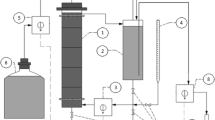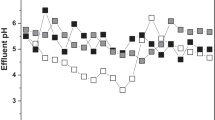Abstract
The main objective of this work was to investigate the effect of volumetric loading rate (VLR), shock load, and alkalinity supplementation on the efficiency and stability of an Anaerobic Sequencing Batch Biofilm Reactor (AnSBBR) containing polyurethane foam cubes. Mixing in the reactor, which was kept at 30 ± 1°C, occurred by recirculating the liquid phase. The reactor treated 2.5 l cheese whey in 8-h cycles, at concentrations of 1, 2, and 4 g COD l−1, which corresponded to VLRs of 3, 6, and 12 g COD l−1 day−1, respectively. Application of single-cycle shock loads of 6, 12, and 24 g COD l−1 day−1 did not impair reactor performance. In addition, for VLRs of 3, 6, and 12 g COD l−1 day−1, alkalinity supplementation to the influent, at the end of each assay, could be reduced to 75, 50, and 50%, respectively, in relation to supplementation at the beginning of the assay. During reactor operation a viscous polymer-like material was formed between the polyurethane foam cubes, which increased at higher VLR. Finally, addition of salts to the influent improved reactor efficiency.









Similar content being viewed by others
Abbreviations
- AnSBBR:
-
anaerobic sequencing batch biofilm reactor
- UASB:
-
up-flow anaerobic sludge blanket
- COD:
-
chemical oxygen demand
- VLR:
-
volumetric loading rate, g COD l−1 day−1
- SOL:
-
specific organic load, mg COD g TVS−1 day−1
- C ST :
-
organic matter concentration in unfiltered effluent samples, mg COD l−1
- C SF :
-
organic matter concentration in filtered effluent samples, mg COD l−1
- BA:
-
bicarbonate alkalinity, mg CaCO3 l−1
- TVA:
-
total volatile acids concentration, mg HAc l−1
- TS:
-
total solids concentration, mg l−1
- TVS:
-
total volatile solids concentration, mg l−1
- TSS:
-
total suspended solids concentration, mg l−1
- VSS:
-
volatile suspended solids concentration, mg l−1
- VAI :
-
intermediate volatile acids concentration, mg HAc l−1
- V CH4 :
-
methane production, ml
- %CH4 :
-
methane percentage in the biogas, %
- %CO2 :
-
carbon dioxide percentage in the biogas, %
- v S :
-
liquid phase recirculation velocity, cm s−1
- Q :
-
volumetric flow rate, l h−1
- C SI :
-
organic matter concentration in unfiltered influent samples, mg COD l−1
- C S :
-
organic matter concentration in unfiltered samples in the reactor along a cycle, mg COD l−1
- V :
-
reaction medium volume in the reactor, l
- R S :
-
organic matter consumption rate, mg COD l−1 h−1
- μ S :
-
specific organic matter consumption rate, mg COD g TVS h−1
- C X-TVS :
-
total volatile solids concentration relative to the reaction medium, g TVS l reaction medium-1
- C X-TS :
-
total solids concentration relative to the reaction medium, g TS l reaction medium−1
- C’X-TVS :
-
total volatile solids concentration relative to the immobilized biomass, mg TVS g foam−1
- C’X-TS :
-
total solids concentration relative to the immobilized biomass, mg TS g foam−1
- μ :
-
specific biomass growth rate, mg TVS g TVS−1 h−1
- Y X/S :
-
organic matter–biomass conversion factor, mg TVS mg COD−1
- M TVS :
-
mass of total volatile solids in the reactor, g TVS
- μ max :
-
Maximum specific biomass growth rate, mg TVS g TVS h−1
- k S :
-
Monod’s kinetic constant, mg COD l−1
- K :
-
first order apparent kinetic constant, l g TVS−1 h−1
- C SR :
-
residual filtered organic matter concentration, mg COD l−1
- C SIO :
-
filtered organic matter concentration in the reactor at the beginning of the cycle, mg COD l−1
- k 1 :
-
first order apparent kinetic constant, h−1
- T :
-
cycle length, h
- ROLF :
-
removed organic load for filtered effluent samples, g COD l−1 day−1
- ROLT :
-
removed organic load for unfiltered effluent samples, g COD l−1 day−1
- V A :
-
fed volume or renewed volume per cycle, l
- t c :
-
cycle length, h
- R 2 :
-
squared correlation coefficient
- ɛ :
-
organic matter removal efficiency, %
References
Omil, F., Garrido, J. M., Arrojo, B., & Méndez, R. (2003). Anaerobic filter reactor performance for the treatment of complex dairy wastewater at industrial scale. Water Research, 37, 4099–4108.
Martins, S. D., Guyomar, P. P., Ribeiro, E. R., & Xavier, A. M. F. (2000). Tratamento anaeróbio em duas etapas do soro de queijo empregando-se duas configurações de reatores UASB. In Latin–American workshop and seminar on anaerobic digestion (vol. 2, pp. 9–12). Recife: UFPE.
Yan, J. Q., Lo, K. V., & Pinder, K. L. (1992). Instability caused by high strength of cheese whey in a UASB reactor. Biotechnology and Bioengineering, 41, 700–706.
Malaspina, F., Stante, L., Cellamare, C. M., & Tilche, A. (1995). Cheese whey and cheese factory wastewater treatment with a biological anaerobic–aerobic process. Water Science and Technology, 32, 59–72.
Ergüder, T. H., Tezel, U., Güven, E., & Demirer, G. N. (2000). Anaerobic biotransformation and methane generation potential of cheese whey in a batch and UASB reactors. Waste Management, 21, 643–650.
Ghaly, A. E., Ramkumar, D. R., Sadaka, S. S., & Rochon, J. D. (2000). Effect of reseeding and pH control on the performance of a two-stage mesophilic anaerobic digester operating on acid cheese whey. Canadian Agricultural Engineering, 42, 173–183.
Li, P., & Mulligan, C. N. (2005). Anaerobic treatment of waste beer. Environmental Progress, 24, 88–95.
Ndegwa, P. M., Hanilton, D. W., Lalman, J. A., Cumba, H. J. (2005). Optimization of anaerobic sequencing batch reactors treating dilute swine slurries. Transactions of the ASAE, 48, 1575–1583.
Mohan, S. V., Rao, N. C., Prasad, K. K., & Sarma, P. N. (2005). Bioaugmentation of an anaerobic sequencing batch biofilm reactor (AnSBBR) with immobilized sulphate reducing bacteria (SRB) for the treatment of sulphate chemical wastewater. Process Biochemistry, 40, 2849–2857.
Mohan, S. V., Babu, V. L., Bhaskar, Y. V., & Sarma, P. N. (2007). Influence of recirculation on the performance of anaerobic sequencing batch biofilm reactor (AnSBBR) treating hypersaline composite chemical wastewater. Bioresource Technology, 98, 1373–1379.
Demirel, B., Yenigun, O., & Onay, T. T. (2005). Anaerobic treatment of dairy wastewaters: A review. Process Biochemistry, 1–13.
Malaspina, F., Cellamare, C. M., Stante, L., & Tilche, A. (1996). Anaerobic treatment of cheese whey with a downflow–up-flow hybrid reactor. Bioresource Technology, 55, 131–139.
Mockaitis, G., Ratusznei, S. M., Rodrigues, J. A. D., Zaiat, M., & Foresti, E. (2006). Anaerobic whey treatment by a stirred sequencing batch reactor (ASBR): effects of organic loading and supplemented alkalinity. Journal of Environmental Management, 79, 198–206.
Zaiat, M., Cabral, A. K. A., & Foresti, E. (1994). Horizontal-flow anaerobic immobilized sludge reactor for wastewater treatment: Conception and performance evaluation. Brazilian Journal of Chemical Engineering, 11, 33–42.
Varesche, M. B., Zaiat, M., Vieira, L. G. T., Vazoller, R. F., & Foresti, E. (1997). Microbial colonization of polyurethane foam matrices in horizontal-flow anaerobic immobilized-sludge reactor. Applied Microbiology Biotechnology, 48, 534–538.
Ramos, A. C. T., Ratusznei, S. M., Rodrigues, J. A. D., & Zaiat, M. (2003). Mass transfer improvement of a fixed-bed anaerobic sequencing batch reactor with liquid phase circulation. Journal of Science and Technology of the Americas - Interciencia, 28, 214–219.
Standard Methods for the Examination of Water and Wastewater (1995). APHA, AWAA, WPCF. Washington D.C., American Public Health Association. 19th Edn.
Acknowledgments
This study was supported by the Fundação de Amparo à Pesquisa do Estado de São Paulo—FAPESP (São Paulo, Brasil), process number 03/09216-4. We also acknowledge Dr. Baltus C. Bonse for the revision of this paper.
Author information
Authors and Affiliations
Corresponding author
Rights and permissions
About this article
Cite this article
Bezerra, R.A., Rodrigues, J.A.D., Ratusznei, S.M. et al. Whey Treatment by AnSBBR with Circulation: Effects of Organic Loading, Shock Loads, and Alkalinity Supplementation. Appl Biochem Biotechnol 143, 257–275 (2007). https://doi.org/10.1007/s12010-007-8030-1
Received:
Accepted:
Published:
Issue Date:
DOI: https://doi.org/10.1007/s12010-007-8030-1




